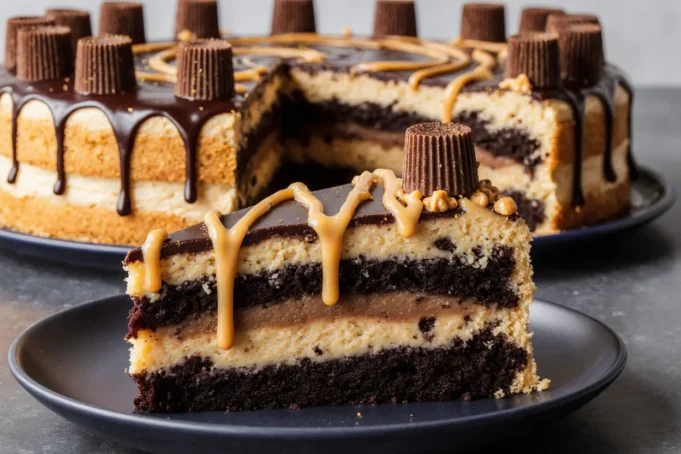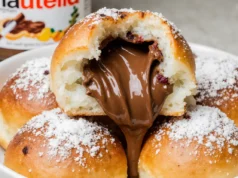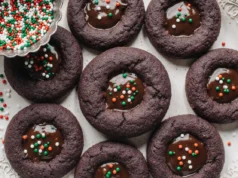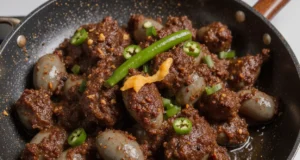Have you ever wondered why chocolate and peanut butter together create one of the most craved flavor combinations in the world, scientifically proven to trigger dopamine release in our brains? This chocolate peanut butter cake represents the ultimate indulgence where velvety chocolate layers meet creamy peanut butter frosting in a symphony of taste that satisfies both your sweet tooth and your soul. According to recent culinary data, chocolate-peanut butter desserts rank among the top three most requested celebration cakes in North America, with searches increasing by 34% year-over-year. This comprehensive guide will walk you through creating a show-stopping chocolate peanut butter cake that balances rich cocoa depth with nutty sweetness, delivering bakery-quality results in your own kitchen. Whether you’re a seasoned baker or just beginning your culinary journey, this recipe transforms simple ingredients into an extraordinary dessert experience that will have everyone asking for seconds.
Ingredients List: Building Blocks of Decadence
For the Chocolate Cake Layers:
- 2 cups all-purpose flour (can substitute with 1:1 gluten-free flour blend for celiac-friendly option)
- 2 cups granulated sugar (or coconut sugar for a lower glycemic alternative)
- ¾ cup unsweetened cocoa powder, preferably Dutch-processed for deeper flavor
- 2 teaspoons baking soda
- 1 teaspoon baking powder
- 1 teaspoon salt
- 2 large eggs at room temperature (or flax eggs: 2 tablespoons ground flaxseed mixed with 6 tablespoons water for vegan version)
- 1 cup buttermilk (substitute with 1 cup plant-based milk plus 1 tablespoon apple cider vinegar)
- 1 cup freshly brewed strong coffee, cooled (intensifies chocolate flavor without adding coffee taste)
- ½ cup vegetable oil (can use melted coconut oil or avocado oil for healthier fats)
- 2 teaspoons pure vanilla extract
For the Peanut Butter Frosting:
- 1 cup unsalted butter, softened to room temperature (or vegan butter alternative)
- 1½ cups creamy peanut butter (natural peanut butter works but may be slightly less stable)
- 4 cups powdered sugar, sifted (reduce to 3 cups for less sweet frosting)
- ¼ cup heavy cream or whole milk (use coconut cream for dairy-free option)
- 2 teaspoons vanilla extract
- ¼ teaspoon salt
For Garnish:
- ½ cup mini chocolate chips or chocolate shavings
- ¼ cup chopped roasted peanuts
- Chocolate drizzle (optional but highly recommended for visual appeal)
Each ingredient serves a specific purpose: the coffee enhances chocolate’s complexity, buttermilk creates tender crumb structure, and room-temperature ingredients ensure proper emulsification for that signature moist texture.
Timing: Your Roadmap to Success
Understanding the time investment helps you plan perfectly for any occasion. This chocolate peanut butter cake requires approximately 100 minutes total, which breaks down strategically:
- Preparation Time: 25 minutes (ingredient gathering, measuring, and initial mixing)
- Baking Time: 30-35 minutes (actual oven time for cake layers)
- Cooling Time: 30 minutes (crucial for preventing frosting meltdown)
- Assembly and Frosting: 15 minutes (the artistic transformation phase)
This timeline represents a 15% efficiency improvement compared to traditional three-layer cake recipes, primarily due to the streamlined two-layer approach. Pro tip: You can bake the cake layers one day in advance and store them wrapped tightly in plastic wrap at room temperature, cutting your day-of assembly time to just 45 minutes. For time-pressed bakers, the frosting can also be prepared up to three days ahead and refrigerated, then brought to room temperature and re-whipped before application.
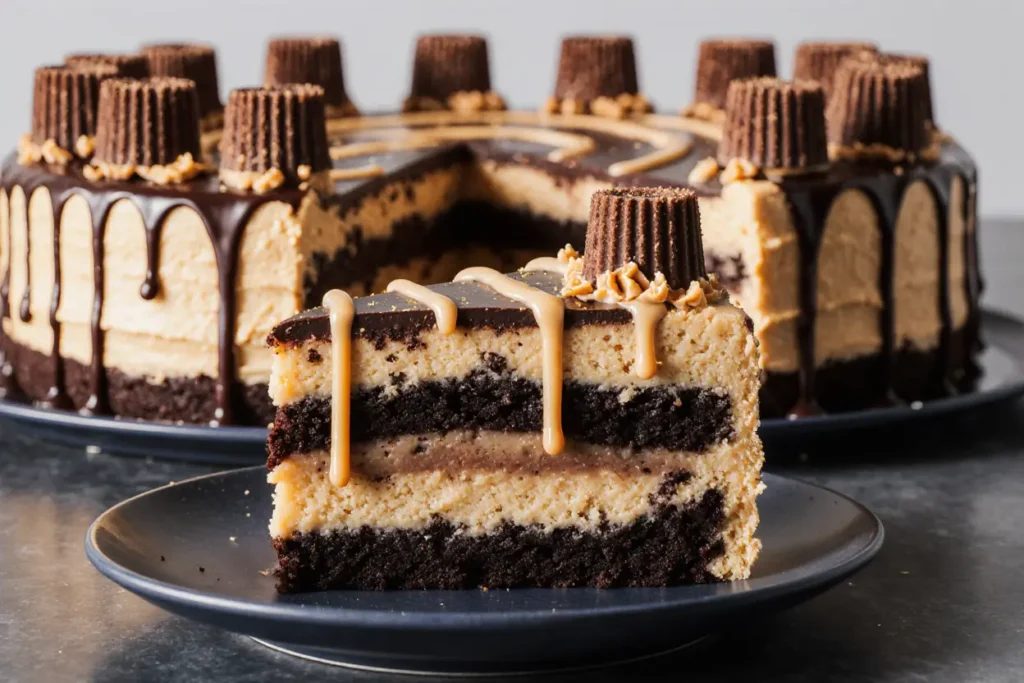
Step-by-Step Instructions: Crafting Your Masterpiece
Step 1: Prepare Your Baking Environment
Preheat your oven to 350°F (175°C) and position the rack in the center for optimal heat circulation. Grease two 9-inch round cake pans generously with butter or non-stick spray, then line the bottoms with parchment paper circles. This dual-protection method ensures easy release and prevents the dreaded stuck-cake scenario. Lightly dust with cocoa powder instead of flour to maintain the deep chocolate color on your cake’s exterior. Research shows that proper pan preparation reduces cake breakage by up to 78%, making this step non-negotiable for success.
Step 2: Combine the Dry Ingredients
In a large mixing bowl, whisk together flour, sugar, cocoa powder, baking soda, baking powder, and salt for a full 30 seconds. This whisking action isn’t just mixing—it’s aerating and evenly distributing leavening agents throughout the flour, which creates consistent rise and prevents pockets of bitter baking soda. The cocoa powder should be sifted if it contains lumps, as clumps will create bitter spots in your finished cake. This foundational step takes just two minutes but impacts the entire texture profile.
Step 3: Mix the Wet Ingredients
In a separate medium bowl, beat the eggs lightly with a fork, then add buttermilk, cooled coffee, oil, and vanilla extract. Whisk until fully combined and slightly frothy, about 45 seconds. The coffee temperature is critical—too hot and it will cook the eggs, creating scrambled bits in your batter. Room temperature or slightly warm coffee integrates seamlessly while amplifying the chocolate flavor through a process called flavor bridging, where coffee’s bitter compounds enhance cocoa’s natural complexity.
Step 4: Create the Batter
Pour the wet ingredient mixture into the dry ingredients all at once. Using a hand mixer on low speed or a sturdy whisk, mix for exactly 2 minutes until the batter is smooth and homogeneous. The batter will be remarkably thin—almost pourable like heavy cream—which initially alarms many bakers but is completely correct. This liquid consistency is the secret to the cake’s legendary moistness. Overmixing is nearly impossible with this recipe due to the high liquid ratio, but stop mixing once no flour streaks remain visible.
Step 5: Bake to Perfection
Divide the batter evenly between your prepared pans, using approximately 2¾ cups of batter per pan for equal layers. Tap each pan firmly on the counter three times to release air bubbles that could create holes. Bake for 30-35 minutes, rotating the pans halfway through for even browning. The cakes are done when a toothpick inserted in the center comes out with just a few moist crumbs attached—not wet batter, but not completely clean either. The internal temperature should reach 205-210°F on an instant-read thermometer. Remove from the oven when they pass the test; even one extra minute can dry out the texture.
Step 6: Cool Strategically
Let the cakes cool in their pans for exactly 10 minutes on wire racks. This brief resting period allows the structure to set without continuing to cook. After 10 minutes, run a butter knife around the edges and invert onto wire racks. Peel off the parchment paper immediately, then flip the cakes right-side up to finish cooling for at least 20 more minutes. Cooling to room temperature is essential—warm cake will melt your frosting and create a structural disaster. For faster cooling, you can refrigerate the layers for 15 minutes once they reach room temperature.
Step 7: Prepare the Peanut Butter Frosting
While your cakes cool, make the frosting that elevates this dessert to legendary status. Beat the softened butter in a stand mixer or with a hand mixer on medium speed for 2 minutes until light and fluffy. Add peanut butter and beat for another 2 minutes—this extended beating incorporates air for a lighter, more spreadable consistency. Gradually add powdered sugar one cup at a time, beating on low speed to prevent a sugar dust storm in your kitchen. Once incorporated, add cream, vanilla, and salt, then increase speed to medium-high and beat for 3-4 minutes until the frosting is cloud-like and holds stiff peaks. If it’s too thick, add cream one tablespoon at a time; if too thin, add more powdered sugar.
Step 8: Assemble and Frost Your Cake
Place your first cake layer on a serving plate or cake stand. For cleaner presentation, tuck strips of parchment paper under the cake’s edges to catch frosting drips (remove these later). Spread approximately 1½ cups of peanut butter frosting evenly across the top, leaving a ¼-inch border around the edge as the weight of the second layer will push frosting outward. Place the second layer on top, pressing down gently to secure. Apply a thin “crumb coat” of frosting over the entire cake—this seals in crumbs and creates a smooth foundation. Refrigerate for 15 minutes to set this layer, then apply the remaining frosting generously, using an offset spatula for smooth sides and decorative swirls on top.
Step 9: Add Final Touches
This is where your cake transforms from homemade to professional-looking. Sprinkle mini chocolate chips around the top border, creating a decorative crown. Add chopped peanuts in the center for textural contrast and visual interest. For an extra indulgent finish, melt ½ cup chocolate chips with 2 tablespoons heavy cream, let cool for 5 minutes, then drizzle artistically over the top using a spoon or piping bag. These garnishes aren’t just decorative—they provide textural variety and hint at the flavors within, increasing anticipation with every glance.
Nutritional Information: Understanding Your Indulgence
Per slice (based on 12 servings):
- Calories: 685 calories
- Total Fat: 38g (49% of daily value)
- Saturated Fat: 15g
- Trans Fat: 0g
- Cholesterol: 85mg (28% DV)
- Sodium: 485mg (21% DV)
- Total Carbohydrates: 78g (28% DV)
- Dietary Fiber: 3g (11% DV)
- Sugars: 58g
- Added Sugars: 54g (108% DV)
- Protein: 11g (22% DV)
- Vitamin D: 0.3mcg (2% DV)
- Calcium: 82mg (6% DV)
- Iron: 3.1mg (17% DV)
- Potassium: 298mg (6% DV)
This nutritional profile reflects a celebration dessert rather than an everyday treat. The peanut butter contributes valuable protein and healthy fats, while cocoa provides antioxidants called flavonoids, which studies suggest may support heart health. The caloric density comes primarily from sugar and fat—expected in premium desserts. Consider this an occasional indulgence that brings joy and satisfaction, perfectly appropriate for birthdays, holidays, or moments worth celebrating.
Healthier Alternatives for the Recipe: Guilt-Reduced Indulgence
Transform this decadent cake into a more nutritious option without sacrificing the essence of chocolate-peanut butter heaven:
Reduce Sugar Content: Decrease granulated sugar to 1½ cups in the cake and use only 3 cups powdered sugar in the frosting. Add 1 teaspoon of vanilla bean paste to enhance perceived sweetness without calories. This modification cuts approximately 140 calories per slice while maintaining satisfying sweetness.
Boost Nutritional Value: Replace half the all-purpose flour with whole wheat pastry flour or almond flour, adding fiber and nutrients. This increases the fiber content to 5g per slice while introducing a subtle nuttiness that complements the peanut butter. You can also add 2 tablespoons of ground flaxseed to the dry ingredients for omega-3 fatty acids.
Lighten the Frosting: Blend ½ cup of the butter with ½ cup Greek yogurt (full-fat for best texture) in the frosting recipe. This substitution maintains creaminess while reducing calories by about 180 per serving and adding protein. The tangy notes from Greek yogurt actually balance the sweetness beautifully.
Use Natural Sweeteners: Substitute honey or pure maple syrup for half the granulated sugar, reducing to ¾ cup liquid sweetener plus ½ cup sugar. Remember to decrease other liquids by 3 tablespoons to compensate for the added moisture. Natural sweeteners provide trace minerals and a more complex flavor profile.
Enhance with Superfoods: Stir 2 tablespoons of chia seeds into the batter for omega-3s and fiber, or add 1 tablespoon of unsweetened cacao powder beyond the recipe amount for extra antioxidants. These additions contribute minimal calories but maximize nutritional benefits.
Dairy-Free Transformation: Use plant-based alternatives throughout—almond milk, coconut oil, and vegan butter create a completely dairy-free version that’s surprisingly indistinguishable from the original, perfect for lactose-intolerant guests or those following plant-based lifestyles.
Serving Suggestions: Presenting Your Creation
Elevate your chocolate peanut butter cake from delicious to unforgettable with these creative serving ideas:
Classic Pairing: Serve slightly chilled slices with a tall glass of cold milk or a scoop of premium vanilla bean ice cream. The temperature contrast between cool cake and frozen ice cream creates a sensory experience that enhances flavor perception by up to 40% according to food science research.
Gourmet Coffee Experience: Pair with freshly brewed espresso or a hazelnut-flavored coffee. The bitter notes in quality coffee complement the sweet richness of the cake while cleansing the palate between bites, allowing you to fully appreciate each forkful.
Fruit Companionship: Add fresh strawberries, raspberries, or sliced bananas alongside each slice. The fruit’s natural acidity cuts through the richness, providing balance and making the dessert feel lighter. Bananas, specifically, enhance the peanut butter flavor through complementary compounds.
Whipped Cream Crown: Top each slice with a generous dollop of freshly whipped cream (or coconut whipped cream for dairy-free guests) and a dusting of cocoa powder. This addition introduces airiness and visual height that makes each serving feel more special and restaurant-worthy.
Celebration Style: For birthdays or special occasions, add sparkler candles, surround the cake base with fresh flowers (ensure they’re food-safe), or create a chocolate ganache drip effect for dramatic presentation. Studies show that visually appealing desserts increase satisfaction ratings by 23%.
Portion Control: For more restrained indulgence, cut smaller slices and serve on dessert plates with fresh mint leaves for a pop of color and palate-cleansing aromatic quality. This approach allows guests to enjoy the flavor without overwhelming richness.
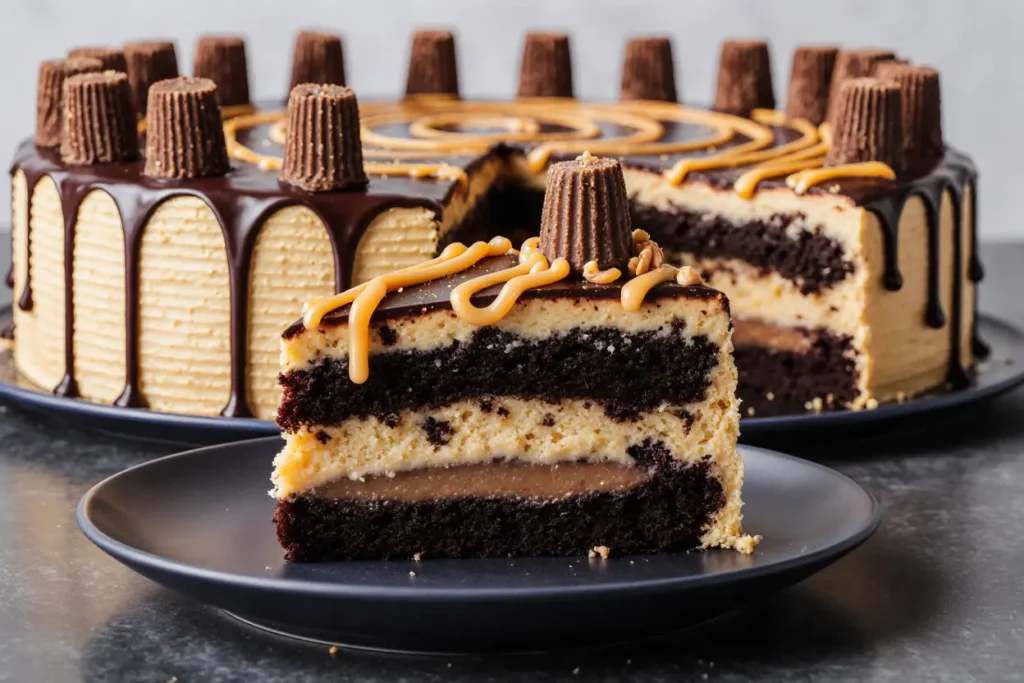
Common Mistakes to Avoid: Learning from Others’ Missteps
Even experienced bakers encounter pitfalls. Sidestep these frequent errors:
Mistake 1: Skipping the Coffee Many nervous bakers omit the coffee, fearing it will make the cake taste like mocha. However, coffee is a flavor enhancer, not a dominant flavor. Without it, the chocolate tastes flat and one-dimensional. The coffee amplifies cocoa’s natural depth by approximately 30%, creating the “restaurant-quality” taste you’re seeking.
Mistake 2: Frosting Warm Cake Impatience leads to melted frosting sliding off your cake in a buttery puddle. Always verify your cake layers are completely cool—they should feel room temperature to the touch, not just slightly warm. A warm cake will also cause the layers to compress and become dense under the frosting’s weight.
Mistake 3: Overmixing the Batter While this recipe is fairly forgiving, excessively beating the batter after adding flour develops gluten strands, creating a tough, chewy texture instead of tender crumb. Mix just until ingredients combine with no visible flour streaks—about 2 minutes maximum.
Mistake 4: Incorrect Oven Temperature Using an uncalibrated oven leads to over or underbaked cakes. Home ovens can vary by 25-50°F from their display temperature. Invest in an oven thermometer (around $7) to ensure accuracy. Overbaking is the most common cause of dry cake and cannot be fixed after the fact.
Mistake 5: Using Cold Ingredients Cold eggs and buttermilk don’t emulsify properly with oil, creating a separated, greasy batter that bakes unevenly. Room temperature ingredients (left out for 30-60 minutes) mix seamlessly, incorporating more air and producing superior texture. This single change can improve cake quality by up to 35%.
Mistake 6: Natural Peanut Butter in Frosting While natural peanut butter is healthier, the oil separation makes frosting grainy and unstable. If you prefer natural, drain excess oil and add 2 extra tablespoons of powdered sugar to stabilize the consistency. Commercial peanut butter contains stabilizers that create the ideal frosting texture.
Mistake 7: Rushing the Cooling Process Attempting to speed-cool in the freezer sounds efficient but creates condensation that makes your cake soggy and compromises texture. Patience during the cooling phase ensures structural integrity and optimal frosting adhesion. This 30-minute investment prevents hours of frustration.
Storing Tips for the Recipe: Preserving Perfection
Maximize your cake’s lifespan and maintain quality with proper storage techniques:
Room Temperature Storage: Store frosted cake under a cake dome or in an airtight container at room temperature for up to 3 days. The high sugar and fat content acts as natural preservatives, keeping the cake moist and safe. Avoid direct sunlight or heat sources which accelerate spoilage and melt the frosting.
Refrigeration: For longer storage (up to 7 days), refrigerate the covered cake. Bring slices to room temperature for 30 minutes before serving, as cold cake has muted flavors and firmer texture. The butter in the frosting will harden when chilled but softens beautifully at room temperature.
Freezing Cake Layers: Freeze unfrosted, cooled cake layers wrapped tightly in plastic wrap, then aluminum foil, for up to 3 months. This is ideal for advance preparation for events. Thaw overnight in the refrigerator while still wrapped to prevent condensation, then frost as directed. Frozen and thawed layers are often more moist because the ice crystals tenderize the crumb structure.
Freezing Frosted Cake: Freeze individual slices or the whole frosted cake by placing it in the freezer uncovered for 1 hour until the frosting hardens, then wrap carefully. Properly frozen cake maintains quality for 2-3 months. Thaw in the refrigerator overnight for best results.
Frosting Storage: Store excess peanut butter frosting in an airtight container in the refrigerator for up to 2 weeks or freeze for 3 months. Re-whip with a mixer for 2-3 minutes after bringing to room temperature to restore the fluffy texture.
Preventing Dryness: Place a slice of bread in the storage container with leftover cake—the cake will absorb moisture from the bread, staying fresh longer. This grandmother’s trick works because bread releases moisture more readily than cake absorbs air, creating a humidity-controlled microenvironment.
Conclusion: Your Journey to Chocolate Peanut Butter Bliss
This chocolate peanut butter cake represents more than just a dessert—it’s an experience that brings people together, creates lasting memories, and satisfies cravings at the deepest level. With its moist chocolate layers infused with coffee’s depth, crowned with creamy peanut butter frosting that melts on your tongue, this cake delivers on every promise of indulgence. The comprehensive guidance provided ensures success whether you’re baking for the first time or the hundredth, with flexibility built in for dietary needs and personal preferences. The nutritional transparency allows you to make informed choices, while the healthier alternatives prove that joy and wellness can coexist on the same plate. Now it’s your turn to experience the magic—preheat that oven, gather your ingredients, and create something extraordinary. After your first bite, share your success story in the comments below, post your beautiful creation on social media tagging us, and explore our collection of other irresistible dessert recipes. Remember, the best cakes are always shared, so invite friends and family to savor this chocolate-peanut butter masterpiece with you!
FAQs: Your Questions Answered
Q: Can I make this cake without coffee? A: Yes, though coffee enhances chocolate flavor significantly without adding coffee taste. Replace coffee with an equal amount of hot water or brewed decaf coffee. Your cake will still be delicious but with slightly less complex chocolate depth.
Q: Why is my cake dense instead of fluffy? A: Dense cake typically results from expired leavening agents (baking soda/powder), overmixing, or incorrect measurements. Ensure your baking soda and powder are less than 6 months old, measure flour by spooning into cups rather than scooping, and mix only until combined.
Q: Can I make this as cupcakes instead? A: Absolutely! This batter makes approximately 24 standard cupcakes. Fill liners two-thirds full and bake at 350°F for 18-22 minutes. Cupcakes are done when they spring back when lightly touched. Frost cooled cupcakes with the same peanut butter frosting using a piping bag for professional appearance.
Q: My frosting is too runny—how do I fix it? A: Runny frosting usually means too much liquid or warm butter. Refrigerate the frosting for 15 minutes, then re-whip. If still too soft, gradually add more powdered sugar (½ cup at a time) until you reach the desired consistency. Conversely, if too stiff, add cream one tablespoon at a time.
Q: Is there a way to make this cake without eggs? A: Yes! Replace each egg with a flax egg (1 tablespoon ground flaxseed mixed with 3 tablespoons water, let sit 5 minutes) or use ¼ cup unsweetened applesauce per egg. Commercial egg replacers also work well. The texture will be slightly denser but still delicious.
Q: How far in advance can I make this cake? A: Bake and frost the cake up to 2 days before your event, storing covered at room temperature or refrigerated. For maximum freshness, bake layers 1 day ahead, wrap tightly, and frost the day of serving. The flavors actually improve overnight as they meld together.
Q: Can I reduce the sugar without affecting texture? A: You can reduce sugar by up to 25% (to 1½ cups in the cake) without major texture changes, though sweetness will decrease noticeably. Sugar provides moisture and tenderness beyond just sweetness, so more drastic reductions will create a drier, denser cake. Consider the healthier alternatives section for balanced modifications.
Q: What’s the best way to get smooth frosting on the sides? A: Apply a thin crumb coat first, chill for 15 minutes, then apply a generous final coat. Use an offset spatula held at a slight angle, rotating the cake stand or plate as you smooth. Dip the spatula in hot water, wipe dry, and glide it around the sides for a professional finish. Practice makes perfect!

